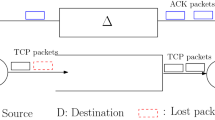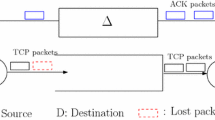Abstract
As the transmission speeds of emerging data networks scale up, the effects of propagation delays, which do not scale, become quite consequential for the design of sliding windows which are needed for congestion control. It was previously shown that optimal window lengths grow linearly with transmission speed λ, thus making the cost of memory for buffers a major factor. However, it was also shown that the moments of the number of packets in the buffers are onlyO(\(\sqrt {{\mathbf{ }}\lambda }\)), the remaining packets are in the course of being propagated. This fact underlies the proposal made here which requires smallO(\(\sqrt {{\mathbf{ }}\lambda {\mathbf{ }}ln{\mathbf{ }}\lambda }\)) buffers and yet guarantees that the ratio of the realized throughput to the ideal throughput approaches unity with increasing λ. That is, buffers when properly sized overflow so rarely that even with a rudimentary (conversely, easily implemented) protocol like go-back-n, the loss in throughput due to retransmissions is negligible. This result is arrived at by obtaining an explicit characterization for large λ of thetail of the distribution of buffer occupancy in the closed network with window sized buffers; in the case of a single-hop virtual circuit the characterization is by a Gaussian conditioned to be nonnegative. Numerical and simulation results are presented to corroborate the performance predictions of the theory for the case of 45 Mbits/sec transmission speed.
Similar content being viewed by others
References
M. Reiser, A queueing-network analysis of computer communication networks with window flow control, IEEE Trans. Commun. COM-27 (1979) 1199–1209.
M.C. Pennotti and M. Schwartz, Congestion control in store and forward tandem links, IEEE Trans. Commun. COM-33 (1975) 1434–1443.
A.A. Lazar, Optimal flow control of a class of queueing networks in equilibrium, IEEE Trans. Auto. Contr. AC-28 (1983) 1001–1007.
S. Stidham, Jr., Optimum control of admission to a queueing system, IEEE Trans. Auto. Contr. AC-30 (1985) 705–713.
V. Jacobson, Congestion avoidance and control,Proc. ACM SIGCOMM, Stanford, CA (1988) pp. 314–329.
K.K. Ramakrishnan and R. Jain, A binary feedback scheme for congestion avoidance in computer networks with a connectionless network layer,Proc. ACM SIGCOMM, Stanford, CA (1988) pp. 303–313.
L. Zhang, A new architecture for packet switching network protocols, Ph.D. thesis, M.I.T., Laboratory for Computer Science, Cambridge, MA (1989).
S.P. Morgan, Window flow control on a trunked byte-stream virtual circuit, IEEE Trans. Commun. COM-36 (1988) 816–825.
M. Schwartz,Telecommunication Networks: Protocols, Modeling and Analysis (Addison-Wesley, Reading, MA, 1987).
A.S. Tanenbaum,Computer Networks (Prentice-Hall, Englewood Cliffs, NJ, 1988).
D. Bertsekas and R. Gallager,Data Networks (Prentice-Hall, Englewood Cliffs, NJ, 1987).
D. Mitra, Asymptotically optimal design of congestion control for high speed data networks, IEEE Trans. Commun. COM-40 (1992) 301–311.
M.I. Reiman, Some diffusion approximations with state space collapse, in:Modelling and Performance Evaluation Methodology, eds. F. Baccelli and G. Fayolle (Springer, New York, 1984) pp. 209–240.
A. Konheim, A queueing analysis of two ARQ protocols, IEEE Trans. Commun. COM-28 (1980) 1004–1014.
D. Towsley and J.K. Wolf, On the statistical analysis of queue lengths and waiting times for statistical multiplexers with ARQ retransmission strategies, IEEE Trans. Commun. COM-27 (1979) 693–702.
D. Towsley, A statistical analysis of ARQ protocols operating in a nonindependent error environment, IEEE Trans. Commun. COM-29 (1979) 869–875.
A. Mukherjee, L.H. Landweber and J.C. Strikwerda, Evaluation of retransmission strategies in a local area network environment, Perf. Eval. Rev. 17 (1989) 98–107.
D.T.D. Luan and D.M. Lucantoni, Throughput analysis of a window-based flow control subject to bandwidth management,Proc. IEEE INFOCOM '88 (IEEE Computer Society Press, 1988) pp. 4C.3.1–4C.3.7.
K. Sabani and A. Netravali, A high speed transport protocol for datagram/virtual circuit networks,Proc. ACM SIGCOMM (1989) pp. 146–157.
Z. Rosberg and N. Shacham, Resequencing delay and buffer occupancy under the selective-repeat ARQ, IEEE Trans. Inf. Theory IF-35 (1989) 166–173.
J.A. Reeds, private communication (1989).
R.P. Kurshan, private communication (1989).
J.P. Buzen, Computational algorithms for closed queueing networks with exponential servers, Comm. ACM 16 (1973) 527–531.
M. Reiser and H. Kobayashi, Queueing networks with multiple closed chains: theory and computational algorithms, IBM J. Res. Devel. 19 (1975) 283–294.
C.H. Sauer and K.M. Chandy,Computer Systems Performance Modeling (Prentice-Hall, Englewood Cliffs, NJ, 1981).
H. Heffes, Moment formulae for a class of mixed multi-job-type queueiing networks, Bell Syst. Tech. J. 61 (1982) 709–745.
J. McKenna, D. Mitra and K.G. Ramakrishnan, A class of closed Markovian queueing networks: integral representations, asymptotic expansions and generalizations, Bell Syst. Tech. J. 60 (1981) 599–641.
M. Abramowitz and I.A. Stegun,Handbook of Mathematical Functions (Dover, New York, 1970) chapter 19.
E. Gelenbe and I. Mitrani,Analysis and Synthesis of Computer Systems (Academic Press, New York, 1980).
A. DeSimone, private communication (1989).
D. Mitra and J.B. Seery, Dynamic adaptive windows for high speed data networks: theory and simulations,Proc. ACM SIGCOMM (1990) pp. 30–40.
D. Mitra and J.B. Seery, Dynamic adaptive windows for high speed data networks with multiple paths and propagation delays,Proc. IEEE INFOCOM '91 (IEEE Computer Society Press, 1991) pp. 39–48.
Author information
Authors and Affiliations
Additional information
Work done while visiting AT&T Bell Laboratories.
Rights and permissions
About this article
Cite this article
Mitra, D., Mitrani, I. Efficient window flow control for high speed data networks with small buffers. Ann Oper Res 49, 1–24 (1994). https://doi.org/10.1007/BF02031589
Issue Date:
DOI: https://doi.org/10.1007/BF02031589




